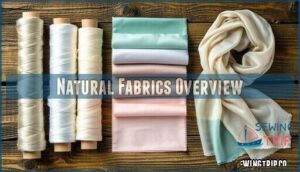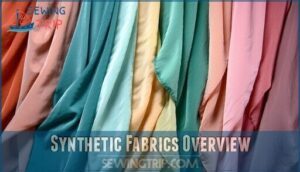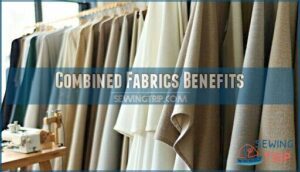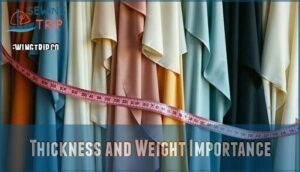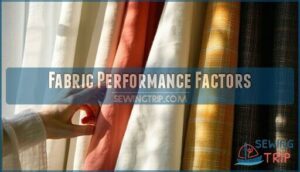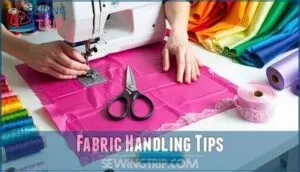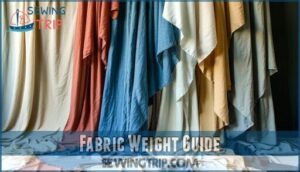This site is supported by our readers. We may earn a commission, at no cost to you, if you purchase through links.
 Choosing fabric for a dress can feel overwhelming, but it’s all about balancing the design with the fabric’s properties.
Choosing fabric for a dress can feel overwhelming, but it’s all about balancing the design with the fabric’s properties.
For flowy dresses, go for lightweight fabrics like chiffon or silk; these drape beautifully and move like a dream.
Want structure? Medium-weight options like cotton sateen or linen are reliable picks.
Pay attention to fabric weight (measured in GSM) to match the season—lightweight for summer, heavier for colder months.
Test the stretch and texture; a bit of give can save you some sewing frustration.
Prewash to avoid surprises later, and don’t underestimate the importance of good shears.
Ready to start stitching?
Table Of Contents
Key Takeaways
- Match fabric weight and drape to your dress style—light fabrics for flowy designs, medium for everyday wear, and heavyweight for structure and warmth.
- Prewash fabric to avoid post-sewing surprises like shrinkage or color bleeding.
- Use cotton or linen for breathable fabrics, and avoid tricky ones like silk or chiffon until you’re more experienced.
- Choose the right lining fabric, like breathable cotton or durable polyester, to complement your dress and improve comfort.
Fabric Types Explained
When choosing fabric for a dress, it’s important to understand the differences between natural, synthetic, and blended options.
Each type offers unique properties that affect comfort, durability, and style, so knowing what works best can save you time and frustration.
Natural Fabrics Overview
Natural fabrics are your go-to for breathable, versatile dressmaking fabrics, blending comfort with style effortlessly.
Breathable and versatile, natural fabrics effortlessly combine comfort and style, making them perfect for any dressmaking adventure.
These natural fibers shine in every season:
- Cotton Benefits: Lightweight and comfy, it’s perfect for casual and everyday dresses.
- Linen Durability: Ideal for summer, linen stays breezy, durable, and softens with wear.
- Silk Luxury: Smooth and elegant, it adds instant glamour to evening wear.
- Wool Warmth: Cozy yet stylish, wool excels in winter dresses, keeping you snug fashionably.
Synthetic Fabrics Overview
Synthetic fabrics bring practicality and creativity to the sewing table.
Polyester stands out for its durability and wrinkle resistance, ideal for casual or travel-friendly dresses.
Nylon impresses with strength in lightweight garments, while acrylic offers warmth without heavy layers.
Rayon, valued for its softness, complements flowy, breathable designs.
Don’t miss microfiber benefits—soft yet strong, perfect for sophisticated pieces like polyester satin.
Spandex shines in fabric stretch, ensuring flexibility and comfortable, flattering fits.
Combined Fabrics Benefits
Blended fabrics are a game-changer for dressmaking, offering durability boosts and enhanced comfort.
Blended fabrics revolutionize dressmaking with unmatched comfort, durability, and versatility—effortlessly combining style and practicality for every occasion.
These performance hybrids combine the best of fabric characteristics, balancing moisture management, wrinkle resistance, and fabric drape.
For instance, polycotton blends deliver cost savings and wearability, making them excellent for everyday outfits, while linen-cotton mixtures enhance breathability for summer dresses.
Fabric blends also bring impressive aesthetic appeal, offering a polished look that lasts.
Whether you’re sewing casual sundresses or sophisticated evening wear, these versatile dress fabric types guarantee long-lasting style and practicality, blending affordability with premium dress fabric properties.
Fiber Blends Advantages
When you choose fabric blends, you’re getting the best of both worlds.
These mixes improve dress fabric properties like durability, comfort, wrinkle resistance, and shape retention. Want a dress that feels soft but survives busy days? Blends deliver.
Cost savings and performance benefits also make them a smart pick. Plus, the unique textures they create add character to your clothing.
For example, woven fabrics offer stability for structured designs. From breathable cotton-polyester to sturdy spandex-nylon, blends balance natural and synthetic fabric characteristics, giving you stylish, durable, and easy-to-maintain dress options.
It’s versatility wrapped in fabric!
Fabric Properties Matter
When sewing a dress, understanding fabric properties is key to achieving the look and feel you want.
From weight and texture to stretch and drape, each detail impacts how the fabric works with your design.
Thickness and Weight Importance
Fabric weight and thickness matter for style, comfort, and seasonal suitability.
A good fabric weight guide helps you match GSM (grams per square meter) to your project:
- Under 200 GSM: Lightweight for airy summer dresses.
- 200-300 GSM: Medium, perfect for daily wear.
- Over 300 GSM: Heavyweight, ideal for winter’s warmth and garment structure.
Texture and Drape Effects
The way a fabric feels (its hand) and hangs (its drape) defines your dress’s character.
Lighter fabrics give you that dreamy, flowy look, while heavier materials bring structure and sophistication.
Need balance? Pair a soft flowy dress fabric with movement or embrace crisp lines with structured materials for contrast.
Here’s a quick fabric drape guide:
| Fabric | Effect | Best For |
|---|---|---|
| Silk | Smooth, elegant | Evening gowns |
| Linen | Textured, breezy | Summer dresses |
| Velvet | Rich, structured | Winter formals |
Sheerness and Opacity Considerations
Sheerness shapes how a dress feels and looks.
Sheer fabrics, with their elegance, often require lining fabrics to handle fabric transparency while maintaining that silhouette impact.
Always check fabric opacity—hold it to light for a quick test.
Thicker fabrics naturally provide better coverage, simplifying layering techniques.
For lighter materials, pick linings that complement textures to avoid clashing.
Remember, your undergarment choice matters too—think seamless for added polish.
Don’t forget, a little prep saves you from unintended wardrobe surprises, and considering these factors will help you achieve the desired silhouette.
Fabric Performance Factors
A fabric’s drape and flow make it graceful, but breathability factors keep it comfy, especially in summer heat.
Wrinkle resistance saves you ironing woes, while wear durability guarantees longevity.
Test color retention to avoid fading disasters.
For the perfect balance, focus on a fabric’s feel, wrinkle resistance, and durability to combine style with practicality.
Choosing Right Fabric
Picking the right fabric is essential to making a dress that fits well, feels comfortable, and looks great.
You’ll want to weigh factors like season, occasion, and fabric properties to guarantee your project turns out just right.
Fabric Selection Criteria
Choosing the perfect dress fabric means balancing comfort considerations, drape importance, and breathability factors with practical needs.
Think about how fabric weight impacts your dress’s look and feel—lightweight for flowy designs, heavier for structure.
Check if the fabric suits your sewing pattern and style while being easy to care for.
Don’t overlook sustainable fabrics for an eco-friendly touch.
Remember, durable fabrics mean longer wear, and the right drape enhances your dress’s silhouette.
Prioritize fabric characteristics aligning with your vision for design and functionality.
Seasonal Fabric Choices
Seasonal dress fabric choices start with climate comfort. For sizzling summer dresses, go for breathable cotton or linen.
Winter warmth calls for cozy wool or fleece. Spring textures like airy voile and rayon keep it light yet stylish.
As for autumn hues, tweed and flannel add a cozy feel. Match the season’s vibe, and you’re set!
Occasion-Based Fabric Selection
Different occasions need different dress fabrics.
For formal dresses, fabrics like silk or satin offer elegance and fabric luxury. Casual fabrics such as cotton jersey are perfect for relaxed, everyday comfort.
Party dress styles pop with sequins or chiffon, while brocade adds flair for seasonal events.
Matching your dress fabric occasion to the dress code makes all the difference! Consideration of fabric selection criteria guarantees the chosen material aligns with comfort and performance.
Fabric Handling Tips
Handling fabric properly can save you from frustrating mistakes like uneven seams or ruined material.
Learn essential tips for prewashing, pressing, and working with both beginner-friendly and tricky fabrics to make your sewing smoother and more enjoyable.
Prewashing and Shrinkage Prevention
Skipping prewashing? That’s asking for trouble!
Avoid fabric shrinkage or color mishaps with these steps:
- Set washing temperatures—match care tags.
- Allow for shrinkage rates—cut extra fabric.
- Experiment with washing methods—gentle cycles suit delicate fiber types.
- Test drying techniques—air drying prevents distortion.
- Use softeners sparingly—some fabrics rebel.
Prewashing makes certain fabric’s sewing-ready, fits perfectly, and won’t surprise you post-stitches.
Ironing and Pressing Techniques
After prewashing, ironing sets the tone for wrinkle-free sewing.
Adjust your ironing temperatures to avoid burns. Use pressing tools like tailor’s hams to ace seam pressing and curved edges.
Protect fabrics with a cloth, preventing shine while boosting wrinkle resistance. Understanding fabric-specific heat settings is vital for superior results.
Instead of gliding, press firmly—steaming stubborn wrinkles works too. Always check fabric care instructions to safeguard your hard work and guarantee smooth, professional finishes.
Beginner-Friendly Fabrics
Start with fabric for beginners that moves with you, not against you. Go for Easy-Care Fabrics like cotton, polycotton, and linen—affordable and easy to cut or stitch.
Woven fabric is a great durable choice, while knit fabric, like ponte, adds stretch without slipping. Use Practice Fabrics to test your skills on Simple Projects.
Pre-treating fabrics prevents shrinkage and color bleeding. Stick to Affordable Options until you’ve mastered sewing fabric types.
Challenging Fabrics for Beginners
Some sewing fabric types can feel like a wrestling match! Slippery silks and stretch knits often slide around, making seams tricky. Velvet woes arise from its bulky texture and tendency to shift. Sheer handling with fabrics like chiffon adds frustration since they snag and fray easily.
Bias cuts tend to stretch awkwardly during sewing. If you’re a beginner tackling dressmaking, focus on easy-to-sew fabric like cotton or linen first.
Working with difficult fabric types requires patience and practice. Stable fabric for beginners makes learning smoother and less stressful!
Fabric Weight Guide
Understanding fabric weight is key to creating a dress that feels and looks just right.
It affects everything from how the fabric drapes to its suitability for different seasons and occasions.
GSM and Fabric Weight Relationship
GSM measurement, or grams per square meter, is the magic number behind fabric weight classification.
It affects fabric drape and seasonal suitability for any project.
Here’s a quick cheat sheet:
- 150 GSM: Lightweight, airy, perfect for summer dresses.
- 200 GSM: Balanced, ideal for casual wear.
- 300+ GSM: Sturdy, cozy for colder weather.
- 6 oz = 203 GSM: Converts quickly!
GSM influences texture, comfort, and versatility.
Understanding how to measure fabric weight is essential for successful sewing.
Fabric Weight and Application
Fabric weight, or GSM, shapes your dress’s flow and comfort.
Lightweight fabrics under 136 GSM feel airy, perfect for soft summer styles. Midweight options balance drape and durability, fitting for all-season wear.
Heavyweights over 305 GSM bring warmth and structure, ideal for winter layers or custom dresses.
Understanding fabric weight options is essential for garment selection. Use fabric weight recommendations to match seasonal needs or dress styles—it’s all about the perfect drape influence, achieving the right flow and comfort, and making informed decisions based on fabric weight.
Lightweight Fabrics for Summer
For summer dresses, lightweight summer dress materials like cotton, linen, and rayon excel with their breathability factors and natural moisture-wicking properties.
These breathable dress fabrics keep you cool under the sun.
Stick to light colors for UV protection, and choose vibrant prints with print durability and color retention.
The right lightweight dress fabric turns summer’s heat into breezy comfort and style.
Medium-Weight Fabrics for Daily Use
Medium-weight fabrics are perfect for everyday comfort, blending durability and style beautifully.
They suit structured silhouettes and versatile styles while offering care simplicity.
- Top fabric picks include cotton poplin and tencel twill.
- Breathable options feel great all day.
- Woven fabric gives designs polish and stability.
- Dress fabric weight balances drape and structure.
- Easy-care materials fit into a busy life like an old friend.
Heavyweight Fabrics for Winter
Heavyweight fabrics like brushed wool and baby corduroy are perfect for winter dresses, combining warmth and style.
Wool offers excellent insulation, keeping chills at bay, while denim adds durability for casual wear.
Velvet brings a touch of elegance with its inviting warmth, and corduroy’s textured charm feels both cozy and timeless.
For added structure, heavyweight canvas makes a sturdy, stylish choice.
Frequently Asked Questions (FAQs)
How do I figure out how much fabric I need for a dress?
Think of measuring fabric like planning a road trip—you calculate distance first.
Start with your pattern or dress size, check fabric width, and use charts or instructions to estimate yardage.
Always round up, as this is a complete concept in ensuring you have enough fabric for your project.
Can 2 yards of fabric make a dress?
Yes, 2 yards can make a dress, but it depends on the dress style, your size, and fabric width.
For simpler designs like a shift dress or sleeveless style, it’s usually enough.
How to figure out how much fabric you need for a sewing pattern?
Picture sewing a flowy summer dress—your pattern says it’s knee-length and sleeveless.
Check the fabric width on your pattern, match it with your size, and double-check extras for mistakes or design tweaks, focusing on complete concepts to ensure accuracy.
How many yards should I get for a dress?
You’ll typically need 2 to 3 yards for a standard dress, but double-check your pattern.
Longer or fuller styles, like maxi dresses, may require up to 5 yards.
Always grab extra for mistakes!
What fabric should I use to sew a dress?
Choosing fabric is like picking the soul of your dress—cotton’s breathable and low-maintenance, silk whispers elegance, linen’s breezy for summer, and velvet hugs warmth.
Match the material’s weight, drape, and care needs to your vision.
How to estimate fabric quantity needed accurately?
To estimate fabric quantity, measure body dimensions like bust, waist, and hips, and check your pattern requirements.
Add extra for shrinkage or mistakes.
Lightweight fabrics need more yardage for volume-heavy styles.
What are tips for sewing fray-prone fabrics?
Use sharp scissors or a rotary cutter for clean edges, and finish raw edges with serging or zigzag stitching.
Stabilize seams with interfacing or tape, and handle fabric gently to prevent fraying disasters.
How to maintain durable fabric seams over time?
Reinforce seams with backstitching to prevent unraveling.
Press seams after sewing; it strengthens threads and neatens edges.
For fray-prone fabrics, use pinking shears or sergers.
Avoid overwashing—gentle care keeps seams strong and fabrics intact.
What tools are best for cutting slippery fabrics?
Sharp rotary cutters paired with a non-slip cutting mat work wonders for slippery fabrics.
Weights help stabilize the material, and micro-serrated scissors give extra control.
Avoid rushing—it’s a game of patience and precision, and steady hands!
How to choose lining fabric for dresses?
Choosing lining fabric is like finding a perfect dance partner—it needs to enhance, not steal the show.
Opt for breathable cotton for comfort, silky acetate for glide, or polyester for durability and wrinkle resistance.
Conclusion
Who knew picking fabric could feel like solving a mystery? With this sewing fabric guide for dresses, you’re armed to decode every bolt of material.
Balance design with fabric properties like weight, stretch, and drape. Don’t forget to prewash—shrinkage surprises aren’t fun!
Seasonal fabrics keep you comfy, while beginner-friendly options save you headaches. Whether it’s cotton for ease or chiffon for flair, trust your instincts (and a good pair of shears). Ready to get started?

